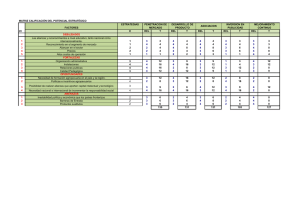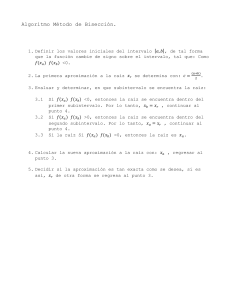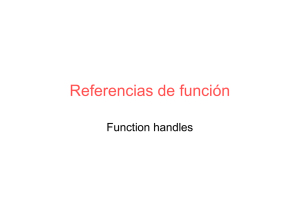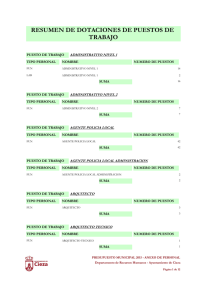Problema. Considere el método de Runge
Anuncio
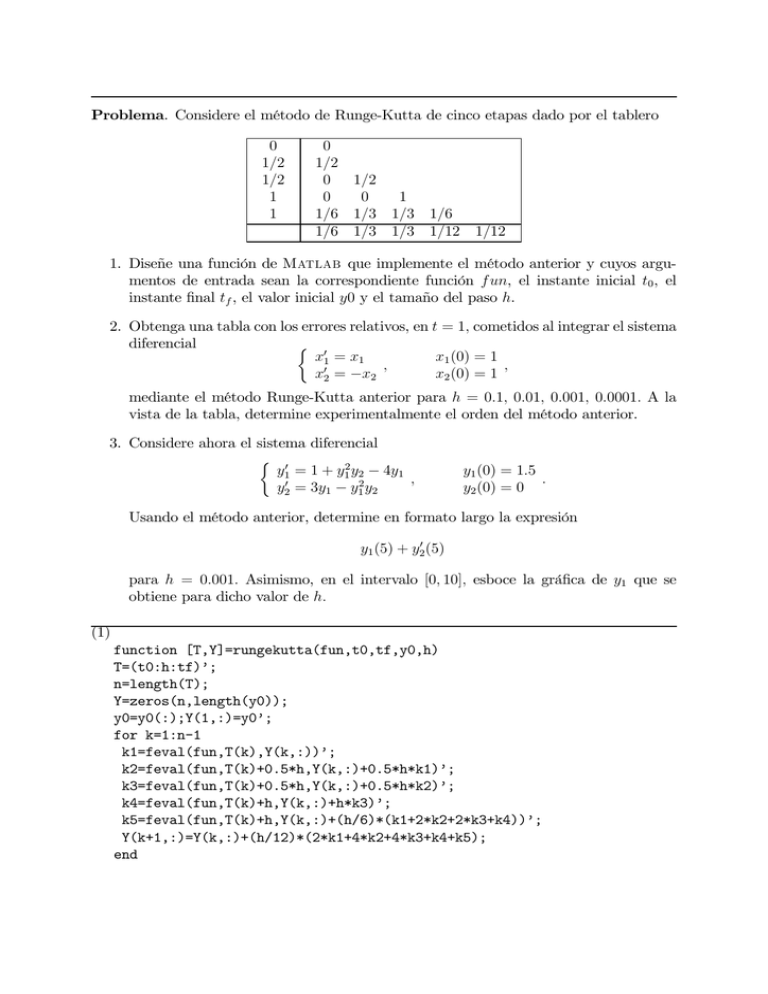
Problema. Considere el método de Runge-Kutta de cinco etapas dado por el tablero 0 1/2 1/2 1 1 0 1/2 0 1/2 0 0 1 1/6 1/3 1/3 1/6 1/6 1/3 1/3 1/12 1/12 1. Diseñe una función de Matlab que implemente el método anterior y cuyos argumentos de entrada sean la correspondiente función f un, el instante inicial t0 , el instante final tf , el valor inicial y0 y el tamaño del paso h. 2. Obtenga una tabla con los errores relativos, en t = 1, cometidos al integrar el sistema diferencial ½ 0 x1 (0) = 1 x1 = x1 , , 0 x2 (0) = 1 x2 = −x2 mediante el método Runge-Kutta anterior para h = 0.1, 0.01, 0.001, 0.0001. A la vista de la tabla, determine experimentalmente el orden del método anterior. 3. Considere ahora el sistema diferencial ½ 0 y1 = 1 + y12 y2 − 4y1 , y20 = 3y1 − y12 y2 y1 (0) = 1.5 . y2 (0) = 0 Usando el método anterior, determine en formato largo la expresión y1 (5) + y20 (5) para h = 0.001. Asimismo, en el intervalo [0, 10], esboce la gráfica de y1 que se obtiene para dicho valor de h. (1) function [T,Y]=rungekutta(fun,t0,tf,y0,h) T=(t0:h:tf)’; n=length(T); Y=zeros(n,length(y0)); y0=y0(:);Y(1,:)=y0’; for k=1:n-1 k1=feval(fun,T(k),Y(k,:))’; k2=feval(fun,T(k)+0.5*h,Y(k,:)+0.5*h*k1)’; k3=feval(fun,T(k)+0.5*h,Y(k,:)+0.5*h*k2)’; k4=feval(fun,T(k)+h,Y(k,:)+h*k3)’; k5=feval(fun,T(k)+h,Y(k,:)+(h/6)*(k1+2*k2+2*k3+k4))’; Y(k+1,:)=Y(k,:)+(h/12)*(2*k1+4*k2+4*k3+k4+k5); end (2) function apartado2(p) h=1; for k=1:p h=h/10; [T,Y]=rungekutta(@fun,0,1,[1,1],h); n=length(T); error_rel=norm(Y(n,:)-[exp(1),exp(-1)])/norm([exp(1),exp(-1)]); fprintf(’h=10^(-%1.0f) Error_Rel=%16.15f\n’,k,error_rel) pause(0.1) end function dydt=fun(t,y) dydt=[y(1);-y(2)]; Ejecutamos el fichero: >> apartado2(5) h=10^(-1) Error_Rel=0.000006743891679 h=10^(-2) Error_Rel=0.000000006924364 h=10^(-3) Error_Rel=0.000000000006942 h=10^(-4) Error_Rel=0.000000000000003 h=10^(-5) Error_Rel=0.000000000000002 El método es de orden tres pues se ganan tres posiciones en cada iteración. (3) function apartado3 [T,Y]=rungekutta(@fun,0,5,[1.5,0],0.001); n=length(T); valor=Y(n,1)+3*Y(n,1)-Y(n,1)^2*Y(n,2); fprintf(’y1(5)+y2(5)=%16.15f\n’,valor) pause [T,Y]=rungekutta(@fun,0,10,[1.5,0],0.001); plot(T,Y(:,1)),shg function dydt=fun(t,y) dydt=[1+y(1)^2*y(2)-4*y(1) 3*y(1)-y(1)^2*y(2)]; Ejecutamos el fichero: >> apartado3 y1(5)+y2(5)=0.933714376481227 2 4 3.5 3 2.5 2 1.5 1 0.5 0 0 2 4 6 3 8 10

